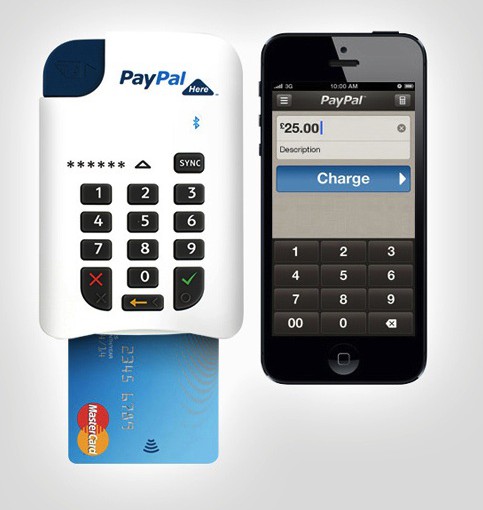A beginner’s guide to mobile payments

Mobile payments. Supposedly they’re going to be huge in 2013, but at the moment it’s a very crowded ecosystem. Are they over – hyped or the next big thing?
The rapid spread of smartphones and the huge rise in online shopping has led to a surge of companies trying to link the two, whether in – store or on the web.
But at the moment there’s no market leader, and as each company is trying to do a bit of everything, it can be a very confusing space to investigate.
To make things simpler, here’s our handy guide to the three kinds of mobile payments, and a look at what this means for fashion retailers.
1. Mobile acceptance:
What is it? Solutions that lets retailers accept card payments by converting a mobile device into a POS system.
How does it work? There’s a hardware element (to accept cards) and a software element (to collect and track payments). Square have, well, a little white square, and Paypal have the calculator – type device shown above.
Examples: Square Register, Paypal Here, i-Zettle
Where do you use it? Retailers use it to accept payments in – store.
Who it benefits: This is a technology for retailers. Specifically, smaller retailers who don’t want to pay the bank fees needed to set up a traditional chip and pin or credit card system.
2. Mobile Wallet
What is it? Mobile apps that are supposed to replace your wallet. You can use them to pay instead of swiping your card or paying in cash.
How does it work? Lots of different ways. Some are powered by NFC technology, so you just wave or tap your phone near a payment terminal. Some work by scanning QR codes. With Square Wallet, when you walk into a store, your name and photo pop up on the cashier’s screen, and you just confirm your name to pay.
Examples: Google Wallet, and all the major credit card companies including Visa PayWave and Mastercard’s MasterPass.
Where do you use it? You use it to pay in shops, although some solutions also work for online payments (like Google Wallet).
Who it benefits: Customers who want an easier way to pay in – store. There is some argument about whether swiping your phone is actually easier than swiping your card. In Japan the system has taken off, with most uses being for small purchases like a newspaper at a train station.
3. Mobile commerce payments
What is it? Paying for products over a mobile device. More specifically, apps that let you enter your details once and then shop with one – click from a variety of different retail apps and mobile websites.
How does it work? Some companies require you to register and then save all your details once you’re logged – in (like Amazon), but this only works on their own website. Others, like SimplyTap, need you to download a new app and register your details, which you can then use to pay in apps or mobile websites that are synced up with the original service – like Pretty Green and Thomas Pink for SimplyTap.
Examples: SimplyTap, MPayMe (not live yet).
Where do you use it? You can pay on websites, in – apps and in – store of participating vendors.
Who it benefits: Both retailers and customers, as it makes it easier and faster to buy products on your phone. We’re watching this category carefully here at Poq to see what companies are doing. At the moment, our apps remember your shipping details after you’ve entered them once, and we offer payments by Paypal. Both of these things work to minimise the amount of typing customers need to do on their phones.
What are the advantage of mobile payments?
There are three big advantages to retailers when it comes to mobile payments.
- Lower fees for taking credit card payments in-store. This space is being shaken up by all the newcomers, and the big card companies are having to change as a result.
- The ability to gather more data about your customers. Knowing that the same person has been browsing products on your shopping app, then paying for them in-store with their mobile phone, could be very useful information when it comes to targeting your marketing.
- An easier way for consumers to pay People currently spend more on credit/debit cards than when they pay in cash. If you make the purchase process even more invisible, there’s a possibility that they might increase their average purchase amount even more, whether that’s in-store, on their mobiles, or online.
Why should fashion retailers care about mobile payments?
Well, the big retailers are starting to sit up and take notice. KFC have recently introduced a mobile wallet system, and just yesterday the news emerged that M&S are planning to trial mobile payments in their coffee shops, using an app called Paddle.
In the fashion world, things are slower. Last year, Aurora introduced a way for customers to pay in – store using Paypal on their phones, although as this article points out, it seems like more of a hassle to set up than the traditional card payments. And last December, Burberry signed a deal with Square to introduce mobile-payment processing in – store.
Smaller and medium – size retailers should be keeping a careful eye on this space, and seeing what emerges as the market continues to develop. There’s no doubt that mobile use in stores is growing, and that the differences between online shopping and in – store shopping are shrinking rapidly. Mobile payments could play a huge part in ecommerce over the next few years.
Read part 2 of this post here to find out what the mobile payment providers think!





